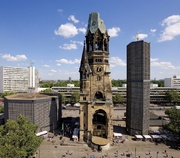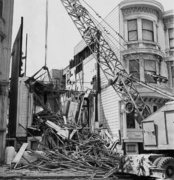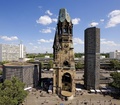
The Defence Line Monument in Novorossiysk, Russia, featuring four giant hands holding PPSh sub-machine guns, opened in 1978 to commemorate the way the city held off a Nazi invasion during World War II. (© FUEL Publishing)
Compared with the sophisticated technology Russia employed to meddle in the 2016 U.S. election, the Soviet propaganda in “Brutal Bloc Postcards,” published by FUEL Design and Publishing, seems downright quaint. Many of these postcards, published by governments of the U.S.S.R. between the 1960s and 1980s, depict the bland, 1960s five-story concrete-paneled apartments known as “khrushchyovka” as if to say, “Look at the modern wonder of collective worker housing!” To Westerners, the boxy buildings telegraph the bleak authority of so-called poured-concrete “Brutalist” architecture, which was somehow popular with both democratic and totalitarian governments during the postwar years.
The Soviet Union failed to live up to its promises of an egalitarian, industrial society, quickly devolving into a brutal, violent dictatorship.
However, in Brutal Bloc Postcards, the images of stern rectilinear apartments, government offices, and hotels stand in stark contrast to the dramatic public monuments. These Cold War-era monuments are epic in scale, towering over the Soviet landscape; their angular, avant-garde forms convey movement, as if hurtling toward brighter future through Communism.
Though most of the memorials were built from the 1960s through the 1980s, the most abstract designs harken back to the Russian Revolution of 1917, when Vladimir Lenin and his Bolsheviks promised to empower workers and take the reins from the Tsarist bourgeois. Back then, hopeful young architects were energized to rethink visual design and city planning to make way for the mobile, modern future. This rethinking provided a lot of fodder for the Constructivist art movement, which originated with Vladimir Tatlin in 1913. Many Constructivist architects subsequently made it their mission to give the proletariat access to the avant-garde and to support the ideals of the Soviet revolution.

A 1980s postcard shows off socialist housing in Belgrade, Serbia. (© FUEL Publishing)
Perhaps the most influential architect of the era was a Swiss Modernist named Le Corbusier. Though his romance with the Soviet regime was brief—Le Corbusier only worked with the Russians from 1928 to 1932—the architect left a lasting impact on Soviet Constructivists like Moisei Ginzburg (the author of Style and Epoch) and made poured concrete the material du jour for Russian Modernists. Interestingly, libertarian icon Ayn Rand, for all her open hatred of the Soviets, seemed to love the austere, functional, and material-focused architecture of Le Corbusier and the Constructivists. In her 1943 novel, The Fountainhead, architect Howard Roark and his affection for concrete bears even more similarities to Le Corbusier than his supposed inspiration, American designer Frank Lloyd Wright.
Of course, the Soviet Union failed to live up to its promises of an egalitarian, industrial society, quickly devolving into the brutal, violent dictatorship of Lenin’s successor, Joseph Stalin. No fan of avant-garde futurism in art and architecture, Stalin insisted that Soviet monuments be sculpted in the life-like style known as “socialist realism,” while buildings were to be decorated in totalitarian grandeur, loaded with purposeless arches and oddly Western scrolling columns. After Stalin died in 1953, Soviet leader Nikita Khrushchev brought back cost-saving, efficient, and austere concrete Modernism for housing, while enormous, breathtaking monuments were erected to honor the soldiers who fought back the Nazis during WWII, the cosmonauts who were conquering outer space, and the laborers who exemplified “the glory of Communism.”
The images in Brutal Bloc Postcards, shot after Khrushchev’s planners erected endless rows of faceless apartments in overcrowded cities, capture the contradictions of the U.S.S.R.—the avant-garde glory of the public spaces and the quiet desperation of worker life. Today, many of these monuments and buildings are abandoned or in ruins.
(If you buy something through a link in this article, Collectors Weekly may get a share of the sale. Learn more.)

















 What America Can Learn From Berlin's Struggle to Face Its Violent Past
What America Can Learn From Berlin's Struggle to Face Its Violent Past
 Laika and Her Comrades: The Soviet Space Dogs Who Took Giant Leaps for Mankind
Laika and Her Comrades: The Soviet Space Dogs Who Took Giant Leaps for Mankind What America Can Learn From Berlin's Struggle to Face Its Violent Past
What America Can Learn From Berlin's Struggle to Face Its Violent Past Demolishing the California Dream: How San Francisco Planned Its Own Housing Crisis
Demolishing the California Dream: How San Francisco Planned Its Own Housing Crisis International PostcardsAfter the Austrian Post Office debuted the first official postcard in Octob…
International PostcardsAfter the Austrian Post Office debuted the first official postcard in Octob… PostcardsPostcards, sometimes spelled out in two words as "post cards," emerged duri…
PostcardsPostcards, sometimes spelled out in two words as "post cards," emerged duri… Politics and Public ServiceHistory is often told through the grand detritus of the political sphere—th…
Politics and Public ServiceHistory is often told through the grand detritus of the political sphere—th… Mari Tepper: Laying it on the Line
Mari Tepper: Laying it on the Line Nice Ice: Valerie Hammond on the Genteel Charm of Vintage Canadian Costume Jewelry
Nice Ice: Valerie Hammond on the Genteel Charm of Vintage Canadian Costume Jewelry How Jim Heimann Got Crazy for California Architecture
How Jim Heimann Got Crazy for California Architecture Modernist Man: Jock Peters May Be the Most Influential Architect You've Never Heard Of
Modernist Man: Jock Peters May Be the Most Influential Architect You've Never Heard Of Meet Cute: Were Kokeshi Dolls the Models for Hello Kitty, Pokemon, and Be@rbrick?
Meet Cute: Were Kokeshi Dolls the Models for Hello Kitty, Pokemon, and Be@rbrick? When the King of Comedy Posters Set His Surreal Sights on the World of Rock 'n' Roll
When the King of Comedy Posters Set His Surreal Sights on the World of Rock 'n' Roll How One Artist Makes New Art From Old Coloring Books and Found Photos
How One Artist Makes New Art From Old Coloring Books and Found Photos Say Cheese! How Bad Photography Has Changed Our Definition of Good Pictures
Say Cheese! How Bad Photography Has Changed Our Definition of Good Pictures Middle Earthenware: One Family's Quest to Reclaim Its Place in British Pottery History
Middle Earthenware: One Family's Quest to Reclaim Its Place in British Pottery History Fancy Fowl: How an Evil Sea Captain and a Beloved Queen Made the World Crave KFC
Fancy Fowl: How an Evil Sea Captain and a Beloved Queen Made the World Crave KFC
Thank you very much for this thoughtful overview of the architectural styles of the Soviet era.
I just wanted to add that, without denigrating anything of what was said of the ugliness and the empty mindedness of the “khrushtschyovkas”, they had served an important public service helping to alleviate the overpopulation problem in the cities. You won’t believe me if I told you that the people were extremely happy and considered themselves very fortunate to be able to move to these luxurious by their standards apartments.
A couple of these monuments look like something off the cover of a 60’s sci-fi paperback.
Thank you very much for this thoughtful overview of the architectural styles of the Soviet era.